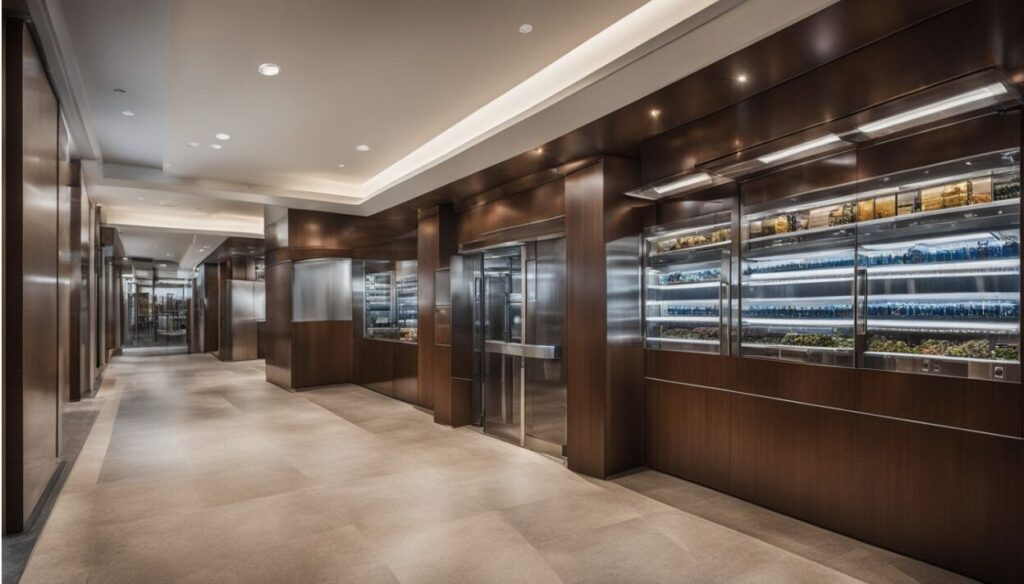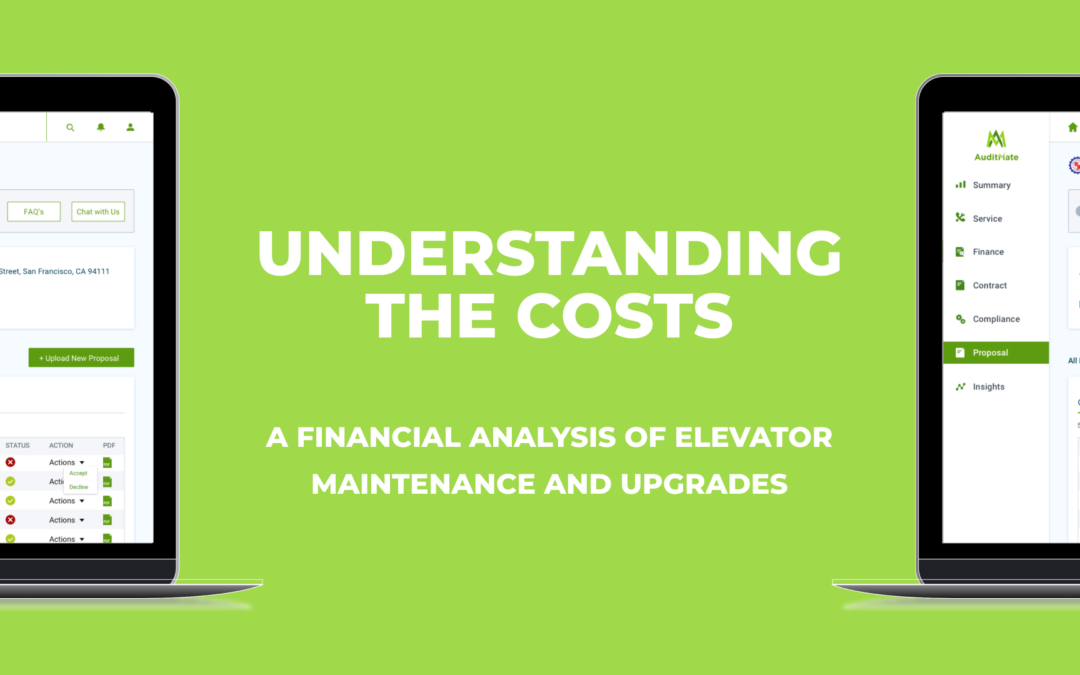Keeping elevators running smoothly is a massive priority for building owners. The price tag for regular elevator maintenance can range from $2,000 to a hefty $14,000 per year for each lift. This article breaks it all down, showing you how to cut costs and steer clear of hiccups.
The Importance of Elevator Maintenance and Upgrades

Keeping elevators in top shape is an absolute operational imperative. It drastically reduces the chances of surprise breakdowns, ensuring lifts are ready to roll when people need them.
Driving factors of elevator maintenance and repairs market
Elevators transport millions of people every day. This makes elevator maintenance and repair services key for buildings, especially those with many floors and high traffic like hospitals. The more an elevator is used, the faster it wears out.
Also, older equipment often needs more fixes to keep running well. Building owners want to avoid breakdowns since they can cause big problems and upset tenants.
The growth of the Elevator Maintenance & Repair market is driven by various factors such as traffic volume, equipment age, maintenance frequency, and chosen maintenance services.
To cut down on downtime and costs in the long run, regular check-ups are important. They help find small issues before they turn into big ones. Plus, choosing the right service plan plays a huge role in managing expenses better over time.
Buildings that see lots of visitors or carry patients need reliable elevators, so picking quality repair services matters a lot for them.
Scope of elevator maintenance and repairs market

The elevator maintenance and repairs market is big. It includes lots of things like fixing broken lifts, keeping them running smoothly, and even upgrading old ones to newer models.
This market was worth $7.1 billion in 2021. Experts say it will grow to $9.4 Billion by 2027. Building owners and people who manage buildings need these services to keep their elevators safe and working well.
But elevator maintenance isn’t just about fixing small issues before they spiral. It’s also about making sure the equipment follows all the rules and regulations set by governing bodies and safety watchdogs. Plus, when elevators run like a well-oiled machine, everyone using that building has a better experience and stays safe.
The money building owners invest in preventative lift maintenance or modernization more than pays for itself over time. Well-maintained elevators increase a property’s value and drastically cut the chances of nasty (and costly) breakdowns.
Financial Benefits of Preventive Maintenance and Upgrades

Putting money into regular elevator care and updates can save you a lot in the long run. This leads to fewer breakdowns, happier people using the elevators, and keeps your building up to code.
Cost savings
Keeping elevators in good shape saves money. Regular checks and fixes stop big problems before they start. This means less cash spent on emergencies. Predictive maintenance uses data to find issues early, making repairs cheaper and easier.
Upgrades also play a big part in saving costs. Modern elevator systems use less energy and break down less often. Over time, these improvements mean spending less on power and repairs.
For building owners, this approach is smart – it makes the building worth more and keeps costs manageable.
Increased reliability and tenant satisfaction
Regular preventive maintenance and smart upgrades make elevators work better and keep people happy. These steps cut down on surprise breakdowns, making sure elevators are ready when needed.
Happy tenants mean they’re more likely to stay, boosting retention rates for building owners.
Upgrading to modern elevator systems shows commitment to comfort and safety, which tenants notice. This leads to higher satisfaction levels. With fewer problems and reliable service, operational costs go down while tenant loyalty goes up.
This creates a win-win for both building owners and those who use the elevators daily.
Minimized malfunctions
Proactive maintenance stops elevators from breaking down. This satisfies everyone because lifts work like they should, without unexpected downtime and entrapments. Keeping up with regular checks makes sure small issues don’t turn into big problems.
This way, buildings stay open for business without any surprises.
Predictive Maintenance uses smart tech to keep an eye on how elevators are doing. It spots problems before they happen. This cuts costs and keeps equipment running smoothly.
Good maintenance is not about fixing what’s broken; it’s about keeping things from breaking in the first place.
Up next, we’ll look at how staying compliant takes elevator maintenance to the next level.
Compliance with regulations
Keeping elevators running smoothly also means avoiding legal trouble. Safety rules demand regular elevator care. This ensures elevators are safe and up to date. Scheduled elevator inspections are a must for every building owner.
They help you dodge fines and keep your building safe.
Meeting these standards is not just about ticking boxes. It is about ensuring everyone in the building can move easily and without worry. Continuous elevator monitoring keeps you ahead of any issues that might pop up, reducing risks and keeping your operations smooth.
Enhanced property value
Proper maintenance and regular upgrades make a building more appealing to tenants and buyers. They look for safety, reliability, and efficiency in elevators. This attention boosts the real estate value of the property.
It turns into a smart investment over time.
Well-kept elevators mean fewer breakdowns and happier people using them. Happy tenants often stay longer, reducing vacancy rates. This steady income from rentals adds to the overall worth of your property.
Next up is how technology plays a role in saving costs on elevator management.
The Role of Technology in Elevator Management and Education for Cost Savings
Technology is changing how we take care of elevators. It helps us save money by making things run smoother and teaching building staff about elevators.
Integration of technology in elevator management
New technologies are changing the way elevators work, making them more efficient and less costly to run. Real-time monitoring systems can now alert building managers as soon as an elevator problem arises.
This quick response cuts down on downtime and repair expenses. Sustainable technology not only saves money but also helps the environment by using less energy.
Virtual reality training is a breakthrough for those who take care of elevators. It teaches staff how to solve problems without having to be in front of an actual elevator. This method is cost-effective and keeps elevators running smoothly with fewer breakdowns.
By embracing these advancements, building owners can see their properties increase in value while enjoying reduced maintenance costs.
Educating building personnel on elevators and escalators
Keeping elevators and escalators running smoothly is key. It saves money and makes buildings work better. Here’s how teaching building staff about them can help:
- Understanding basic operations – Staff learn how elevators and escalators work. This knowledge helps them spot problems early.
- Regular checks – Trained personnel can do simple checks to find issues before they get big.
- Quick fixes for small problems – Knowing how to handle minor repairs can reduce downtime.
- Better safety practices – When staff know the right safety steps, accidents go down.
- Clear communication with repair teams – Staff who know their stuff can explain problems well, making fixes faster.
- Cost savings – Training helps avoid big repairs, saving lots of money over time.
Efficient management and maintenance education mean less spent on repairs and more happy tenants. Next, let’s look at the role technology plays in keeping costs down and efficiency up in elevator management.
Conclusion
Understanding the costs linked to elevator upkeep and modernization is key for building managers trying to keep their budgets in check. With expenses ranging widely, smart maintenance and timely updates can not only cut down costs but also boost building value.
AuditMate steps into this equation as a powerful ally. This software turns complex data into straightforward insights, making it easier to manage vendors and stick to maintenance plans without stress.
For a clearer view on spending less while getting more from your elevators, reach out to AuditMate today.
FAQ
1. How much does it usually cost to maintain an elevator?
Well, maintaining an elevator can cost from $1200 per year to $14,000 per year per piece of lift, depending on the type, number of floors served, usage, and service demand.
2. Do older elevators cost more to maintain?
In most cases, yes, as there are more mechanical devices and fewer no maintenance solid-state features on them.
3. Is upgrading my elevator worth the expense?
Upgrading can be pricey upfront, but it often saves you money and headaches down the road… plus, newer features are pretty cool!
4. What’s the biggest factor that affects maintenance costs?
Usage is a big factor as well as the type of equipment — the more your elevator is used, the more love (and cash) it’ll need to stay happy.
5. Can I reduce my maintenance costs without compromising safety?
Absolutely! Regular check-ups can catch small issues before they turn into big problems… kind of like visiting the doctor regularly keeps you healthy without breaking the bank.

